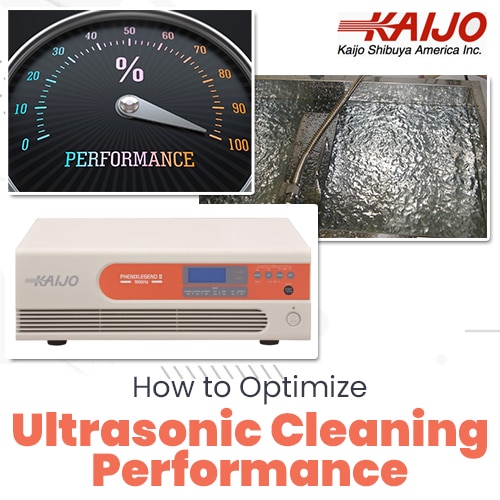How to Optimize Ultrasonic Cleaning Performance
May 23, 2023
 Ultrasonic cleaners can deliver improved cleaning performance over other cleaning methods if the systems are properly optimized for the application. Ultrasonic cleaning system parameters such as frequency, power, and bath temperature need to be chosen to match the requirements of the cleaning application. The type of part to be cleaned and the nature of the contamination can influence the system’s design. Ultrasonic cleaners work quickly and remove all traces of surface contamination if set up correctly. The key is to get expert help from an experienced industrial ultrasonic cleaning equipment manufacturer to select an ultrasonic cleaner that will meet your cleaning requirements.
Ultrasonic cleaners can deliver improved cleaning performance over other cleaning methods if the systems are properly optimized for the application. Ultrasonic cleaning system parameters such as frequency, power, and bath temperature need to be chosen to match the requirements of the cleaning application. The type of part to be cleaned and the nature of the contamination can influence the system’s design. Ultrasonic cleaners work quickly and remove all traces of surface contamination if set up correctly. The key is to get expert help from an experienced industrial ultrasonic cleaning equipment manufacturer to select an ultrasonic cleaner that will meet your cleaning requirements.
Ensuring Ultrasonic Cleaning Effectiveness
Effective cleaning means the removal of contamination down to the original part surface. To ensure that the ultrasonic cleaner can work properly, the frequency must be low enough to deliver the required cleaning intensity. At the same time, surface pitting from frequencies that are too low must be avoided. Parts made from hard materials such as steel or brass can be cleaned at frequencies as low as 26 kHz, but higher frequencies must be used for softer materials. Parts that have a delicate structure or are mechanically fragile also need higher frequencies. Choosing ultrasonic generators to produce the correct frequency is an essential first step for ultrasonic cleaner optimization.
System power is the next parameter that is important for ultrasonic cleaning effectiveness. Ultrasonic cleaners include transducers that flood the ultrasonic cleaning tanks with high-frequency sound waves. The system should be powerful enough to ensure that the ultrasonic waves traveling through the cleaning solution reach all parts of the tank with enough strength to deliver effective cleaning. If the power is too low, there may be dead spots where parts are not cleaned completely.
Optimizing Ultrasonic Cleaners for Efficiency
Ultrasonic cleaners work more quickly than other cleaning methods, but setting them up for maximum efficiency can save additional time. The main factor affecting cleaning speed is the system frequency. Hard, robust parts can be cleaned quickly using the intensive cleaning action of the lowest ultrasonic frequencies. If the parts to be cleaned have softer surfaces, such as aluminum or plastics, higher frequencies in the 78 kHz to 160 kHz range may have to be used to avoid surface pitting. For delicate parts, such as semiconductors or coated materials, using the highest frequencies in the Megahertz range will avoid damaging the parts.
As the frequency rises, the cleaning action becomes less intense. This means that removing contaminants takes place more slowly therefore cleaning times increase. When the use of higher frequencies is required due to the nature of the parts to be cleaned, additional optimizing measures can bring the cleaning times back down.
For oily or greasy residues, heating the cleaning solution softens the contaminant and makes removing it easier. Sometimes adding a mild detergent to the cleaning solution will also speed up cleaning. These measures can reduce cleaning times to levels where ultrasonic cleaning remains an efficient cleaning solution.
Matching the Equipment to the Cleaning Application
For optimal operation of an ultrasonic cleaning system, the equipment must match the cleaning application’s requirements. If a specific contaminant is to be removed from a single type and size of part, it’s easy to size the ultrasonic cleaning tanks to hold the part. The ultrasonic generators can be set up to deliver the single selected frequency, and the cleaning cycle is clearly defined.
On the other hand, if many different parts with a variety of contaminants must be cleaned, the system has to be more flexible. The tanks must be sized to hold the largest of the parts, and the tanks may need baskets to keep small parts from contacting the side of the tank. Ultrasonic generators operating with multiple frequencies may be required and cleaning times may vary. For optimized operation, it may make sense to have several ultrasonic cleaners, each set up for cleaning specific parts rather than having one all-purpose system.
Use an Experienced Ultrasonic Cleaning Manufacturer
An experienced manufacturer of industrial ultrasonic cleaning systems can help ensure an installation operates optimally. Kaijo has the required experience and in-house expertise to fulfill this role. They can advise on the best frequencies for specific parts and contaminants. They can determine how much power is required and have experience using heated baths and detergents.
Performance optimization of an ultrasonic cleaning system starts with defining the cleaning requirements and then selecting a corresponding ultrasonic system. Kaijo can help ensure that the chosen system operates optimally and meets the cleaning performance goals. Contact Kaijo for a free consultation to discuss your specific cleaning requirements.





